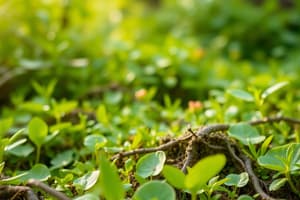Podcast
Questions and Answers
Ecology is the study of the interrelationship of plants and animals with each other and with their environment. An ecosystem refers to organisms and their interactions with their environment. Biosphere is all the parts of the earth where life exists. Habitat is the place where a species lives. Abiotic Factors are non-living features of the environment. Edaphic Factors are abiotic factors relating to soil. Biotic Factors are influences of living organisms on each other. Every species has its own set of conditions that it requires. These are called environmental factors. They include abiotic and biotic factors and vary greatly depending on whether the environment is terrestrial (land) or aquatic (water). Each species has adaptations to its environment, Adaptations are the features of an organism that allow it to have a better chance of survival in its habitat. Environmental factors affecting living organisms Biotic Factors - Feeding: If a species is used as food by another species, then its population will be reduced. If a species that is used as food is plentiful, then the consumer will become more numerous as it will be able to produce and feed more young. - Disease: Disease is generally caused by other living things. Disease usually reduces populations, sometimes very significantly. - Pollination: The transfer of pollen from an anther to a stigma. Carried out by insects such as bees.
Bees scarcity impacts pollination and seed production, affecting plant populations
Bees scarcity impacts pollination and seed production, affecting plant populations
bees
Nitrogen-fixing bacteria maintain soil fertility, found in leguminous plants’ root nodules and free-living soil, replacing nitrates
Nitrogen-fixing bacteria maintain soil fertility, found in leguminous plants’ root nodules and free-living soil, replacing nitrates
nitrogen-fixing bacteria
Decomposers break down dead remains for soil reuse
Decomposers break down dead remains for soil reuse
Climatic factors like light intensity, temperature, and exposure affect plant and animal distribution
Climatic factors like light intensity, temperature, and exposure affect plant and animal distribution
Edaphic factors such as pH, mineral content, water, and humus influence soil fertility and plant growth
Edaphic factors such as pH, mineral content, water, and humus influence soil fertility and plant growth
Flashcards
Ecology
Ecology
The study of how plants and animals interact with each other and their environment.
Ecosystem
Ecosystem
Organisms and their interactions with their environment.
Biosphere
Biosphere
All parts of Earth where life exists.
Habitat
Habitat
Signup and view all the flashcards
Abiotic Factors
Abiotic Factors
Signup and view all the flashcards
Edaphic Factors
Edaphic Factors
Signup and view all the flashcards
Biotic Factors
Biotic Factors
Signup and view all the flashcards
Environmental Factors
Environmental Factors
Signup and view all the flashcards
Terrestrial
Terrestrial
Signup and view all the flashcards
Aquatic
Aquatic
Signup and view all the flashcards
Adaptations
Adaptations
Signup and view all the flashcards
Feeding (biotic factor)
Feeding (biotic factor)
Signup and view all the flashcards
Disease (biotic factor)
Disease (biotic factor)
Signup and view all the flashcards
Pollination
Pollination
Signup and view all the flashcards
Nitrogen-fixing bacteria
Nitrogen-fixing bacteria
Signup and view all the flashcards
Decomposers
Decomposers
Signup and view all the flashcards
Climatic factors
Climatic factors
Signup and view all the flashcards
Edaphic factors
Edaphic factors
Signup and view all the flashcards
Bees
Bees
Signup and view all the flashcards
Environmental factor affecting organisms
Environmental factor affecting organisms
Signup and view all the flashcards
Study Notes
Abiotic Factors Affecting Ecosystems
- Bees scarcity impacts pollination and seed production, affecting plant populations
- Nitrogen-fixing bacteria maintain soil fertility, found in leguminous plants’ root nodules and free-living soil, replacing nitrates
- Decomposers break down dead remains for soil reuse
- Climatic factors like light intensity, temperature, and exposure affect plant and animal distribution
- Edaphic factors such as pH, mineral content, water, and humus influence soil fertility and plant growth
- Terrestrial and aquatic habitats have different examples of altitude, aspect, and steepness effects
- Climatic factors like temperature, humidity, day length, and light intensity affect plant and animal behavior
- Wind causes physical damage and spreads spores, pollen, and seeds
- Soil pH, type, organic matter, water content, air content, and mineral content affect plant growth
- Aquatic habitats face challenges like light penetration, currents, wave action, salinity, oxygen, and tides
- Plankton thrive in upper water layers due to light, while limpets attach and withstand wave action
- Organisms adapt to freshwater or saltwater due to salinity, and tides affect exposure and water retention in shore plants
Studying That Suits You
Use AI to generate personalized quizzes and flashcards to suit your learning preferences.




